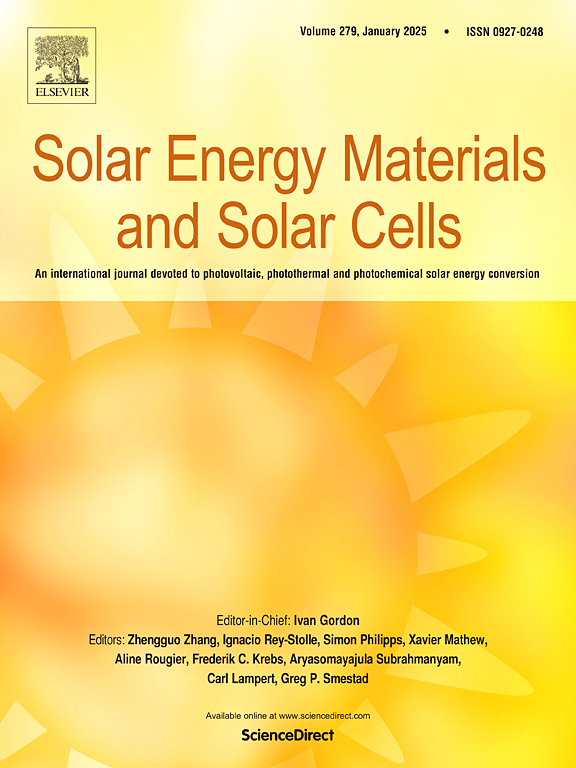Boron-emitter development for TOPCon c-Si solar cells based on plasma-deposited boron diffusion source and poly-Si(n) passivating contact
IF 6.3
2区 材料科学
Q2 ENERGY & FUELS
引用次数: 0
Abstract
The n-type TOPCon technology is currently the leading approach in the industry. Generally, it involves two high-temperature steps that can result in long cycle times and expensive processes. In this context, we propose a lean manufacturing process based on the successive PECVD-deposition of the front and rear doped layers, followed by a co-annealing step in which front emitter formation and rear passivating contact activation are performed simultaneously. We first investigated the influence of the PECVD process parameters and the thermal budget of the co-annealing step on the active boron concentration profile, the passivation quality, and contact resistivity. Then, we investigated the effect of a drive-in step under O environment to reduce the surface concentration and increase the depth of the emitter. Finally, we investigated the compatibility of the rear passivating contact with the drive-in step. The introduction of the drive-in step made it possible to obtain active boron concentration profiles with the desired surface concentration and depth. However, even though we obtained promising results regarding the compatibility of the rear passivating contact with the drive-in step, we observed that further optimization is necessary to avoid blistering of the n-type poly-Si layer and improve the uniformity of the rear passivation.

基于等离子体沉积硼扩散源和多晶硅钝化触点的TOPCon c-Si太阳能电池硼发射极的研制
n型TOPCon技术是目前业内领先的技术。通常,它涉及两个高温步骤,这可能导致较长的周期时间和昂贵的过程。在这种情况下,我们提出了一种精益制造工艺,该工艺基于前后掺杂层的连续pecvd沉积,随后是一个共退火步骤,其中前发射极形成和后钝化接触激活同时进行。我们首先研究了PECVD工艺参数和共退火步骤的热收支对活性硼浓度分布、钝化质量和接触电阻率的影响。然后,我们研究了在O2环境下驱动步进对降低表面浓度和增加发射器深度的影响。最后,我们研究了后钝化接触与驱动步骤的兼容性。引入驱入步骤可以获得具有所需表面浓度和深度的活性硼浓度曲线。然而,尽管我们在后部钝化接触与驱动步骤的兼容性方面获得了令人鼓舞的结果,但我们发现,为了避免n型多晶硅层起泡并提高后部钝化的均匀性,还需要进一步优化。
本文章由计算机程序翻译,如有差异,请以英文原文为准。
求助全文
约1分钟内获得全文
求助全文
来源期刊

Solar Energy Materials and Solar Cells
工程技术-材料科学:综合
CiteScore
12.60
自引率
11.60%
发文量
513
审稿时长
47 days
期刊介绍:
Solar Energy Materials & Solar Cells is intended as a vehicle for the dissemination of research results on materials science and technology related to photovoltaic, photothermal and photoelectrochemical solar energy conversion. Materials science is taken in the broadest possible sense and encompasses physics, chemistry, optics, materials fabrication and analysis for all types of materials.
 求助内容:
求助内容: 应助结果提醒方式:
应助结果提醒方式:


